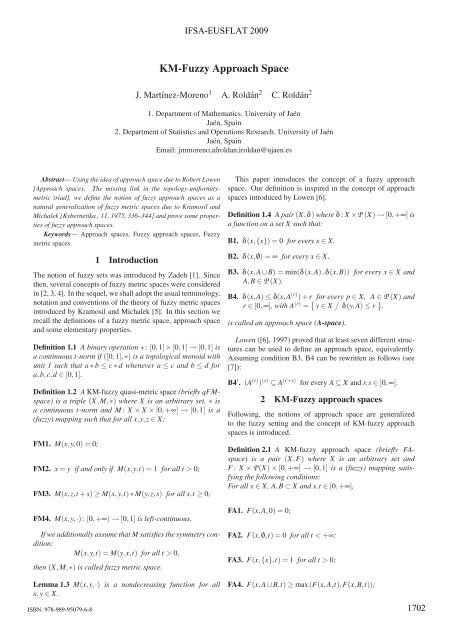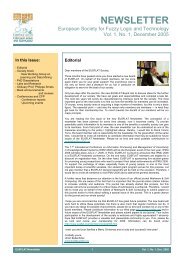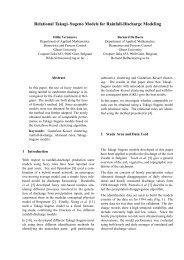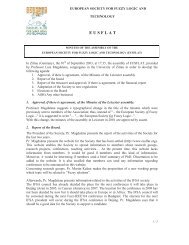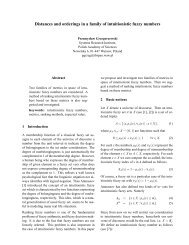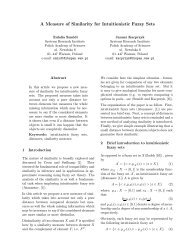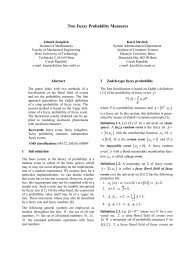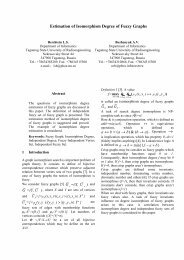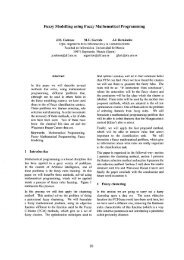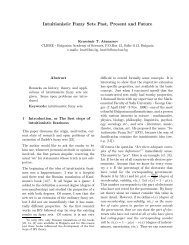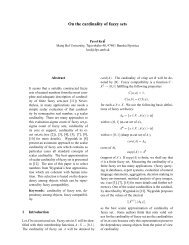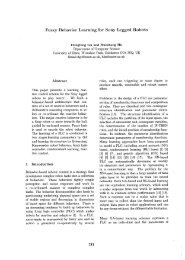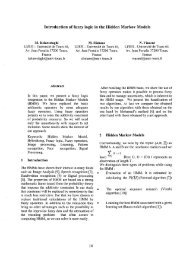KM-Fuzzy Approach Space - EUSFLAT
KM-Fuzzy Approach Space - EUSFLAT
KM-Fuzzy Approach Space - EUSFLAT
You also want an ePaper? Increase the reach of your titles
YUMPU automatically turns print PDFs into web optimized ePapers that Google loves.
<strong>KM</strong>-<strong>Fuzzy</strong> <strong>Approach</strong> <strong>Space</strong><br />
J. Martínez-Moreno 1 A. Roldán 2 C. Roldán 2<br />
1. Department of Mathematics. University of Jaén<br />
Jaén, Spain<br />
2. Department of Statistics and Operations Research. University of Jaén<br />
Jaén, Spain<br />
Email: jmmoreno,afroldan,iroldan@ujaen.es<br />
Abstract— Using the idea of approach space due to Robert Lowen<br />
[<strong>Approach</strong> spaces. The missing link in the topology-uniformitymetric<br />
triad], we define the notion of fuzzy approach spaces as a<br />
natural generalization of fuzzy metric spaces due to Kramosil and<br />
Michalek [Kybernetika , 11, 1975, 336–344] and prove some properties<br />
of fuzzy approach spaces.<br />
Keywords— <strong>Approach</strong> spaces, <strong>Fuzzy</strong> approach spaces, <strong>Fuzzy</strong><br />
metric spaces.<br />
1 Introduction<br />
The notion of fuzzy sets was introduced by Zadeh [1]. Since<br />
then, several concepts of fuzzy metric spaces were considered<br />
in [2, 3, 4]. In the sequel, we shall adopt the usual terminology,<br />
notation and conventions of the theory of fuzzy metric spaces<br />
introduced by Kramosil and Michalek [5]. In this section we<br />
recall the definitions of a fuzzy metric space, approach space<br />
and some elementary properties.<br />
Definition 1.1 A binary operation ∗: [0,1] × [0,1] → [0,1] is<br />
a continuous t-norm if ([0,1],∗) is a topological monoid with<br />
unit 1 such that a ∗ b ≤ c ∗ d whenever a ≤ c and b ≤ d for<br />
a,b,c,d ∈ [0,1].<br />
Definition 1.2 A <strong>KM</strong>-fuzzy quasi-metric space (briefly qFMspace)<br />
is a triple (X,M,∗) where X is an arbitrary set, ∗ is<br />
a continuous t-norm and M : X × X × [0,+∞] → [0,1] is a<br />
(fuzzy) mapping such that for all x,y,z ∈ X:<br />
FM1. M(x,y,0)=0;<br />
FM2. x = y if and only if M(x,y,t)=1 for all t > 0;<br />
FM3. M(x,z,t + s) ≥ M(x,y,t) ∗ M(y,z,s) for all s,t ≥ 0;<br />
FM4. M(x,y,·): [0,+∞) → [0,1] is left-continuous.<br />
If we additionally assume that M satisfies the symmetry condition:<br />
M(x,y,t)=M(y,x,t) for all t > 0,<br />
then (X,M,∗) is called fuzzy metric space.<br />
Lemma 1.3 M(x,y,·) is a nondecreasing function for all<br />
x,y ∈ X.<br />
ISBN: 978-989-95079-6-8<br />
IFSA-<strong>EUSFLAT</strong> 2009<br />
This paper introduces the concept of a fuzzy approach<br />
space. Our definition is inspired in the concept of approach<br />
spaces introduced by Lowen [6].<br />
Definition 1.4 A pair (X,δ) where δ : X ×P (X) → [0,+∞] is<br />
a function on a set X such that:<br />
B1. δ(x,{x})=0 for every x ∈ X.<br />
B2. δ(x, /0)=∞ for every x ∈ X.<br />
B3. δ(x,A ∪ B)=min(δ(x,A),δ(x,B)) for every x ∈ X and<br />
A,B ∈ P (X).<br />
B4. δ(x,A) ≤ δ(x,A (r) )+r for every p ∈ X, A ∈ P (X) and<br />
r ∈ [0,∞], with A (r) = y ∈ X δ(y,A) ≤ r .<br />
is called an approach space (A-space).<br />
Lowen ([6], 1997) proved that at least seven different structures<br />
can be used to define an approach space, equivalently.<br />
Assuming condition B3, B4 can be rewritten as follows (see<br />
[7]):<br />
B4 ′ . (A (r) ) (s) ⊆ A (r+s) for every A ⊆ X and r,s ∈ [0,∞].<br />
2 <strong>KM</strong>-<strong>Fuzzy</strong> approach spaces<br />
Following, the notions of approach space are generalized<br />
to the fuzzy setting and the concept of <strong>KM</strong>-fuzzy approach<br />
spaces is introduced.<br />
Definition 2.1 A <strong>KM</strong>-fuzzy approach space (briefly FAspace)<br />
is a pair (X,F) where X is an arbitrary set and<br />
F : X × P (X) × [0,+∞] → [0,1] is a (fuzzy) mapping satisfying<br />
the following conditions:<br />
For all x ∈ X, A,B ⊂ X and s,t ∈ [0,+∞],<br />
FA1. F(x,A,0)=0;<br />
FA2. F(x, /0,t)=0 for all t < +∞;<br />
FA3. F(x,{x},t)=1 for all t > 0;<br />
FA4. F(x,A ∪ B,t) ≥ max(F(x,A,t),F(x,B,t));<br />
1702
FA5. F(x,A,t + s) ≥ F(x,A (r) ,t), ifs> r ≥ 0,<br />
F(x,A,+∞) ≥ F(x,A (+∞) ,t),<br />
where A (r) = {y ∈ X : F(y,A,t)=1,∀t > r},<br />
and A (+∞) = {y ∈ X : F(y,A,+∞)=1};<br />
FA6. F(x,A,·): [0,+∞) → [0,1] is left-continuous for all x ∈<br />
X and A ⊂ X.<br />
The map F is symmetric (or the FA-space (X,F) is symmetric)<br />
if<br />
F(x,{y},t)=F(y,{x},t) for all x,y ∈ X, t > 0.<br />
Firstly, we will prove that there are two families of spaces<br />
satisfying the above six properties.<br />
Lemma 2.2 (A-space ↩→ FA-space) Let (X,δ) be an Aspace.<br />
If we define a fuzzy set Fδ on X × P (X) × [0,+∞] as<br />
follows:<br />
Fδ (x,A,t)=0 if t ≤ δ(x,A),<br />
Fδ (x,A,t)=1 if t > δ(x,A),<br />
then (X,F δ) is a FA-space.<br />
Proof. FA1, FA2 and FA3 are immediate. In order to<br />
prove FA4, if A,B ⊆ X we can suppose min(δ(x,A),δ(x,B)) =<br />
δ(x,A) ≤ δ(x,B) and, then max(F(x,A,t),F(x,B,t)) =<br />
F(x,A,t). Thus Fδ (x,A ∪ B,t) =0 for t ≤ δ(x,A); and<br />
Fδ (x,A ∪ B,t) =1 for t > δ(x,A). This completes the proof<br />
of FA4.<br />
For every r ∈ [0,+∞), the set A (r) is the same in A-space<br />
and in FA-space, since<br />
A (r)<br />
A−space = x ∈ X δ(x,A) ≤ r <br />
= x ∈ X Fδ (x,A,t)=1,∀t > r = A (r)<br />
FA−space .<br />
Let us suppose that s > r. Since δ(x,A) ≤ δ(x,A (r) )+r, thus<br />
for t ≤ δ(x,A) − s, wehave<br />
t + r < t + s ≤ δ(x,A) ≤ δ(x,A (r) )+r;<br />
i.e., t < δ(x,A (r) ) and F δ(x,A,t + s)=F δ(x,A (r) ,t)=0 for t +<br />
s ≤ δ(x,A).<br />
Otherwise, if t + s > δ(x,A), then F δ(x,A,t + s) =1 ≥<br />
F δ(x,A (r) ,t). This completes the proof.<br />
Theorem 2.3 (FM-space ↩→ FA-space) Let (X,M,∗) be a<br />
FM-space. If we define a fuzzy set F on X × P (X) × [0,+∞]<br />
for every x ∈ X, t ∈ [0,∞] and A ⊆ X as follows:<br />
FM (x,A,t)=sup M (x,a,t),<br />
a∈A<br />
then (X,FM) is a FA-space.<br />
Proof. By FM1 and FM2, conditions FA1 and FA3 hold.<br />
The proof of the second condition FA2 follows from the<br />
definition of supA for empty sets, sup/0 = 0. If x ∈ X and<br />
A,B ⊆ X are subsets of X, then<br />
Max<br />
<br />
sup M (x,a,t), sup M (x,b,t)<br />
a∈A<br />
b∈B<br />
ISBN: 978-989-95079-6-8<br />
<br />
IFSA-<strong>EUSFLAT</strong> 2009<br />
= sup M (x,a,t).<br />
a∈A∪B<br />
Consequently FA4 is proved.<br />
We will prove now FA5. Let x ∈ X, A ∈ P (X) and r ∈ [0,∞].<br />
If A = /0, the condition FA5 is trivial. It is enough to prove that<br />
the property FA5 holds true for every A = /0. Since, for every<br />
x,y,z ∈ X, t,s > 0<br />
in particular,<br />
M(x,z,t + s) ≥ M(x,y,t) ∗ M(y,z,s);<br />
M(x,y,t + s) ≥ M(x,a,t) ∗ M(a,y,s)<br />
for every x ∈ X, a ∈ A (r) , y ∈ A, t > 0,s > r ≥ 0.<br />
Taking supremum over y ∈ A, then<br />
FM (x,A,t + s)=sup M (x,y,t + s)<br />
y∈A<br />
≥ M(x,a,t) ∗ sup M(a,y,s)<br />
y∈A<br />
= M(x,a,t) ∗ FM(a,A,s).<br />
Since, a ∈ A (r) , then FM(a,A,s)=1 for s > r. Thus<br />
FM (x,A,t + s) ≥ M(x,a,t).<br />
Taking supremum over a ∈ A (r) ,wehave<br />
FM (x,A,t + s) ≥ FM(x,A (r) ,t).<br />
Note that additionally the following condition is satisfied:<br />
FA7 Let x,y ∈ X be such that FM (x,{y},t)=1 for every t > 0,<br />
then x = y.<br />
3 Characterization<br />
Now we ask about the maps F : X × P (X) × [0,+∞] → [0,1]<br />
that could provide to X of a FA-space structure. In this cases,<br />
it could be interesting to weaken axioms FA4 and FA5.<br />
Proposition 3.1 Let X be a non-empty set, F : X × P (X) ×<br />
[0,+∞] → [0,1] be a map satisfying axiom FA2 and such that<br />
F (x,A,t)=1 for every t > 0 and x ∈ A ⊆ X. Then:<br />
The axiom FA4 is equivalent to<br />
FA4 ′ . F (x,A ∪ B,t) ≥ Max(F (x,A,t),F (x,B,t)) for t > 0,<br />
for every non-empty subsets A,B ⊆ X such that A = B<br />
and A ∪ B ⊂ X, and for each x ∈ X\(A ∪ B).<br />
The axiom FA5 is equivalent to<br />
FA5 ′ . F(x,A,t +s) ≥ F(x,A (r) ,t) for t > 0, for every s > r ≥<br />
0, /0 = A ⊂ X and for each x ∈ X\A.<br />
Proof. We prove that there exists some cases in which FA4<br />
and FA5 are always true.<br />
Property FA4 ′ .IfA is empty, then F (x,A ∪ B,t)=F (x,B,t)<br />
and, by the axiom FA2<br />
Max(F (x,A,t),F (x,B,t)) = Max(F (x, /0,t),F (x,B,t))<br />
= Max(0,F (x,B,t)) = F (x,B,t).<br />
A similar conclusion is valid for B = /0. We will suppose that<br />
A and B are non-empty sets. If x ∈ A ∪ B, then, by hypothesis,<br />
F (x,A ∪ B,t)=1 ≥ Max(F (x,A,t),F (x,B,t)).<br />
1703
We can suppose that x /∈ A ∪ B, and thus A ∪ B = X is impossible.<br />
So, A ∪ B ⊂ X. IfA = B, the inequality is trivial.<br />
Property FA5 ′ . If r =+∞, the inequality F(x,A,+∞) ≥<br />
F(x,A (+∞) ,t) is obvious. Therefore we can suppose that r <<br />
+∞. IfA is empty, then for each r > 0,<br />
/0 (r) = x ∈ X F (x, /0,t)=1,∀t > r = /0,<br />
and then in FA5 we have the equality. We can suppose that<br />
A is non-empty. If x ∈ A, by hypothesis, F (x,A,t)=1 for all<br />
t > 0. Then<br />
F (x,A,t + s)=1 ≥ F(x,A (r) ,t).<br />
Consequently, we can suppose that x /∈ A.<br />
4 Properties<br />
The closure of a subset A of a FA − space (X,F) can be expressed<br />
by<br />
A = A (0) = {x ∈ X : F(X,A,t)=1,∀t > 0}.<br />
Although the set X has not been endowed with a topology, the<br />
following definition can be considered.<br />
Definition 4.1 A is called closed if A ⊆ A.<br />
Lemma 4.2 Let (x,F) be a FA-space, x∈ X and A ⊆ X.<br />
1. If a ∈ A, then F (a,A,t)=1 for each t > 0.<br />
2. If a ∈ A, then F (x,a,t) ≤ F (x,A,t) for each t > 0.<br />
3. If A ⊆ B ⊆ X, then F (x,A,t) ≤ F (x,B,t) for each t > 0.<br />
4. supF<br />
(x,a,t) ≤ F (x,A,t) for each t > 0.<br />
a∈A<br />
5. If A ⊆ B ⊆ X, then A (r) ⊆ B (r) for each r ≥ 0.<br />
6. Let 0 ≤ r ≤ s, then<br />
A ⊆ A = A (0) ⊆ A (r) ⊆ A (s) ⊆···⊆X.<br />
In particular, F (x,A,t) ≤ F x,A,t .<br />
7. A is closed if and only if A = A.<br />
8. If r ≥ 0, then /0 (r) = /0.<br />
9. x ∈ A (r) if and only if x ∈ A (r+s) for every s > 0.<br />
10. The infimum inf [0,+∞)({r ≥ 0 / x ∈ A (r) }) is really a minimum,<br />
i.e.,<br />
A (r) = <br />
A (s) .<br />
r r and then<br />
F (x,B,t)=1 for each t > r. That is, x ∈ B (r) .<br />
6. If a ∈ A,by1,F (a,A,t)=1 for each t > 0. Thus a ∈ A.<br />
Let r ≤ s. Ifx∈ A (r) , F (x,A,t)=1, for each t > r, then,<br />
in particular, F (x,A,t)=1 for each t > s. Thus x ∈ A (s) .<br />
7. Trivial.<br />
8. By FA2, it is immediate.<br />
9. x ∈ A (r) if and only if F (x,A,t) =1 for all t > r. This<br />
condition is equivalent to the following for each s > r,<br />
Then,<br />
F (x,A,t)=1 for all t > s.<br />
x ∈ A (r) ⇔ x ∈ <br />
A (s) ⇔ x ∈ <br />
A (r+s) .<br />
r0<br />
That is, x ∈ A (r) if and only if x ∈ A (r+s) for all s > 0.<br />
10. By 3, 6 and FA5<br />
if s > 0.<br />
F(x,A,t + s) ≥ F(x,A (r) ,t) ≥ F(x,A,t),<br />
Next, the previous properties are refined.<br />
Lemma 4.3 Let (X,F) be a FA-space, x ∈ X,t ≥ 0 and A ⊆ X.<br />
1. F (x,A,t)=F x,A,t .<br />
2. The closure A is a closed set, that is, A = A.<br />
3. A is closed if and only if for each x ∈ X satisfying<br />
F (x,A,t)=1, with t > 0, then x ∈ A.<br />
4. A (r) is closed for every r ≥ 0.<br />
5. (X,F) satisfies the axiom FA7 if and only if the points are<br />
closed subsets, that is, {x} = {x}.<br />
6. (A (r) ) (s) ⊆ A (r+s) for every r,s ≥ 0.<br />
1704
Proof.<br />
1. Since A ⊆ A, by 3 of lemma 4.2, F (x,A,t) ≤ F x,A,t .<br />
Using axiom FA5 with r = 0, it holds<br />
F (x,A,t + s) ≥ F(x,A (0) ,t)=F(x,A,t)<br />
for s > 0.<br />
Taking infimum on s, wehaveF (x,A,t) ≥ F(x,A,t).<br />
2. By 6 of lemma 4.2, A ⊆ A. Let x ∈ A = A (0)(0) . This is<br />
equivalent to <br />
F x,A (0) <br />
,t = 1<br />
for all t > 0. Using axiom FA5 with r = 0,<br />
F (x,A,t + s) ≥ F(x,A (0) ,t)=1<br />
for t,s > 0. Then x ∈ A (0) = A.<br />
3. Trivial.<br />
<br />
4. Let x ∈ X be such that F x,A (r) <br />
,t = 1 for all t > 0. By<br />
FA5,<br />
<br />
F (x,A,t + s) ≥ F x,A (r) <br />
,t = 1<br />
for all t > 0, s > r ≥ 0. In particular x ∈ A (r) . The previous<br />
property implies that A (r) is closed.<br />
5. Trivial.<br />
6. Let r,s ≥ 0 and x ∈ (A (r) ) (s) , that is,<br />
<br />
F x,A (r) <br />
,t = 1<br />
for all t > s. By FA5,<br />
F (x,A,t + s) ≥ F<br />
<br />
x,A (r) <br />
,t = 1<br />
for t > s > r ≥ 0. Thus x ∈ A (r+s) .<br />
The following proposition is an interesting property related<br />
to closures of subsets of FA-spaces.<br />
Proposition 4.4 Let (X,F) be a FA-space, r ≥ 0 and A,B ⊆ X<br />
subsets of X.<br />
1. A (r) ∪ B (r) ⊆ (A ∪ B) (r) .<br />
2. If (X,F) verifies the equality in FA4, then (A ∪ B) (r) =<br />
A (r) ∪ B (r) .<br />
Proof. Since A ⊆ A ∪ B and B ⊆ A ∪ B, by 5 in lemma 4.2,<br />
A (s) ⊆ (A ∪ B) (s) , B (s) ⊆ (A ∪ B) (s) .<br />
Then A (s) ∪ B (s) ⊆ (A ∪ B) (s) .<br />
Suppose that the equality holds in FA4. If x ∈ (A ∪ B) (r) ,<br />
then<br />
Max(F (x,A,t),F (x,B,t)) = F (x,A ∪ B,t)=1,<br />
for all t > r.<br />
Then, for each t > r,<br />
F (x,A,t)=1orF (x,B,t)=1.<br />
Suppose that t > r is such that F (x,A,t)=1. If s > 0, then<br />
F(x,A,t + s)=F(x,A (r) ,t) ≥ F(x,A,t)=1.<br />
Then F(x,A,t)=1 for all t > r; i.e., x ∈ A (r) .<br />
Consequently, x ∈ A (r) or x ∈ B (r) and then x ∈ A (r) ∪ B (r) .<br />
ISBN: 978-989-95079-6-8<br />
IFSA-<strong>EUSFLAT</strong> 2009<br />
References<br />
[1] Lotfi A. Zadeh. <strong>Fuzzy</strong> sets. Information and Control, 8:338–353,<br />
1965.<br />
[2] A. George and P. Veeramani. On some results in fuzzy metric<br />
spaces. <strong>Fuzzy</strong> Sets Syst, 64:395–399, 1994.<br />
[3] O. Kaleva and S. Seikkala. On fuzzy metric spaces. <strong>Fuzzy</strong> Sets<br />
Syst, 12:215–229, 1984.<br />
[4] D. Mihet. A banach contraction theorem in fuzzy metric spaces.<br />
<strong>Fuzzy</strong> Sets Syst, 144:431–439, 2004.<br />
[5] I. Kramosil and J. Michalek. <strong>Fuzzy</strong> metrics and statistical metric<br />
spaces. Kybernetika, 11:336–344, 1975.<br />
[6] R. Lowen. <strong>Approach</strong> spaces. The missing link in the topologyuniformity-metric<br />
triad. Oxford Mathematical Monographs. Oxford<br />
University Press, 1997.<br />
[7] D. Vaughan R. Lowen, M. Sioen. Completing quasi-metric<br />
spaces - an alternative approach. Houston J. Math., 29:113–136,<br />
2003.<br />
1705


